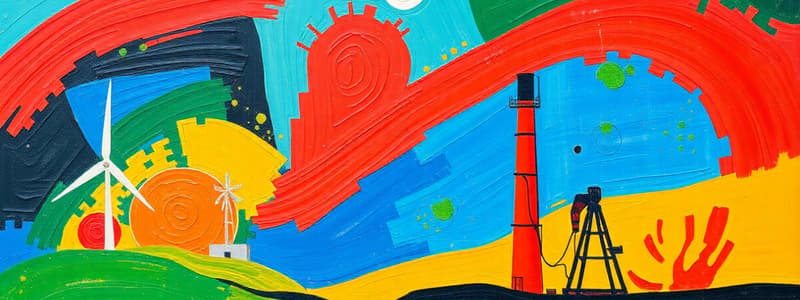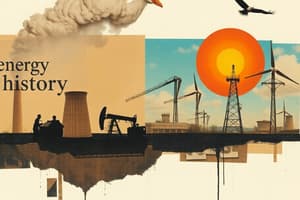Podcast
Questions and Answers
Which fossil fuel had the highest contribution to the total primary energy supply in 2019?
Which fossil fuel had the highest contribution to the total primary energy supply in 2019?
- Oil (correct)
- Biofuels
- Natural gas
- Coal
What was the approximate percentage of renewable energy sources in the world’s energy supply in 2019?
What was the approximate percentage of renewable energy sources in the world’s energy supply in 2019?
- 14% (correct)
- 20%
- 25%
- 10%
How has the share of renewable energy in electricity production changed by 2019?
How has the share of renewable energy in electricity production changed by 2019?
- It has risen (correct)
- It has remained constant
- It has decreased significantly
- It is negligible
Compared to 1970, how has the energy supply share of OECD countries changed by 2019?
Compared to 1970, how has the energy supply share of OECD countries changed by 2019?
What is a significant characteristic of total final consumption compared to total energy supply?
What is a significant characteristic of total final consumption compared to total energy supply?
Why has natural gas production increased more than oil production?
Why has natural gas production increased more than oil production?
What major event caused a temporary downturn in natural gas production?
What major event caused a temporary downturn in natural gas production?
Which country has produced the most energy, primarily through coal?
Which country has produced the most energy, primarily through coal?
What has contributed to the increase in coal production since 2000?
What has contributed to the increase in coal production since 2000?
How does electricity generation primarily occur according to recent trends?
How does electricity generation primarily occur according to recent trends?
Which country is planning to phase out nuclear power but is currently hesitating?
Which country is planning to phase out nuclear power but is currently hesitating?
What significant energy-related incident occurred in Japan in 2011?
What significant energy-related incident occurred in Japan in 2011?
Which country relies heavily on coal for energy, covering about two-thirds of its energy supply?
Which country relies heavily on coal for energy, covering about two-thirds of its energy supply?
What is the primary focus of Germany's 'Energiewende' policy?
What is the primary focus of Germany's 'Energiewende' policy?
What strategy is China employing to address its energy supply challenges?
What strategy is China employing to address its energy supply challenges?
In 2019, what was the significant change in access to electricity?
In 2019, what was the significant change in access to electricity?
What does the Stated Policies Scenario (STEPS) envision for future energy policies?
What does the Stated Policies Scenario (STEPS) envision for future energy policies?
What is predicted regarding fossil fuel use according to the content?
What is predicted regarding fossil fuel use according to the content?
What economic response is caused by high prices in gas and oil markets?
What economic response is caused by high prices in gas and oil markets?
What is a likely scenario regarding the use of coal in the coming years?
What is a likely scenario regarding the use of coal in the coming years?
Which scenario assumes that all government pledges are achieved?
Which scenario assumes that all government pledges are achieved?
What trend is observed in investments compared to fossil fuels?
What trend is observed in investments compared to fossil fuels?
What is one of the projected outcomes of reaching peaks in fossil fuel usage?
What is one of the projected outcomes of reaching peaks in fossil fuel usage?
Which event is associated with the oil price quadrupling during the 1970s?
Which event is associated with the oil price quadrupling during the 1970s?
What primary energy source do high-income economies predominantly rely on?
What primary energy source do high-income economies predominantly rely on?
What is the main mission of OPEC?
What is the main mission of OPEC?
Which of the following crises is associated with a doubling of oil prices?
Which of the following crises is associated with a doubling of oil prices?
What impact do energy crises typically have on oil prices?
What impact do energy crises typically have on oil prices?
Which factor has pressured the traditional wealth transfer mechanism in the oil market?
Which factor has pressured the traditional wealth transfer mechanism in the oil market?
How does OPEC maintain higher oil prices when there are signs of a price drop?
How does OPEC maintain higher oil prices when there are signs of a price drop?
What proportion of the world's oil supply does OPEC control?
What proportion of the world's oil supply does OPEC control?
What is the primary strategy of OPEC+ in managing oil prices?
What is the primary strategy of OPEC+ in managing oil prices?
Which of the following best describes the relationship between OPEC and non-OPEC oil supplies?
Which of the following best describes the relationship between OPEC and non-OPEC oil supplies?
What major change in oil production occurred in the U.S. due to investments in shale oil?
What major change in oil production occurred in the U.S. due to investments in shale oil?
What external costs are associated with consuming oil from OPEC countries?
What external costs are associated with consuming oil from OPEC countries?
What approach have European countries largely taken in response to energy crises?
What approach have European countries largely taken in response to energy crises?
What was one of the steps taken by the Bush administration to reduce oil dependency?
What was one of the steps taken by the Bush administration to reduce oil dependency?
Which is a significant consequence of the low private cost of energy in the U.S.?
Which is a significant consequence of the low private cost of energy in the U.S.?
Which country is not mentioned as a member of the OPEC+ collaboration?
Which country is not mentioned as a member of the OPEC+ collaboration?
Flashcards
Global Energy Sources
Global Energy Sources
Fossil fuels (oil, coal, and natural gas) are the primary sources of energy globally, accounting for a large majority of the world's energy supply.
Renewable Energy Share
Renewable Energy Share
Renewable energy sources, like biofuels, hydropower, and solar, are gaining ground but still constitute a smaller proportion of the world's energy mix.
Total Primary Energy Supply (TPES)
Total Primary Energy Supply (TPES)
The total amount of energy produced from all sources is called Total Primary Energy Supply. This includes the energy lost in the process of turning raw energy sources into usable energy.
Total Final Consumption (TFC)
Total Final Consumption (TFC)
Signup and view all the flashcards
Shifting Energy Consumption
Shifting Energy Consumption
Signup and view all the flashcards
Natural Gas Production Trends
Natural Gas Production Trends
Signup and view all the flashcards
Coal Production Rise
Coal Production Rise
Signup and view all the flashcards
Electricity Generation Sources
Electricity Generation Sources
Signup and view all the flashcards
China's Energy Dominance
China's Energy Dominance
Signup and view all the flashcards
Global Energy Consumption
Global Energy Consumption
Signup and view all the flashcards
Energy Crisis
Energy Crisis
Signup and view all the flashcards
OPEC (Organization of the Petroleum Exporting Countries)
OPEC (Organization of the Petroleum Exporting Countries)
Signup and view all the flashcards
Oil Price Volatility
Oil Price Volatility
Signup and view all the flashcards
Wealth Transfer
Wealth Transfer
Signup and view all the flashcards
Shale Oil
Shale Oil
Signup and view all the flashcards
Quantity Restrictions (by OPEC)
Quantity Restrictions (by OPEC)
Signup and view all the flashcards
OPEC's Price-Fixing Strategy
OPEC's Price-Fixing Strategy
Signup and view all the flashcards
Fossil Fuels
Fossil Fuels
Signup and view all the flashcards
Energy System in Turmoil
Energy System in Turmoil
Signup and view all the flashcards
STEPS Scenario
STEPS Scenario
Signup and view all the flashcards
APS Scenario
APS Scenario
Signup and view all the flashcards
NZE Scenario
NZE Scenario
Signup and view all the flashcards
Fossil Fuel Peak?
Fossil Fuel Peak?
Signup and view all the flashcards
Clean Energy Investment
Clean Energy Investment
Signup and view all the flashcards
Coal Decline
Coal Decline
Signup and view all the flashcards
Clean Energy Investment Trend
Clean Energy Investment Trend
Signup and view all the flashcards
Energiewende
Energiewende
Signup and view all the flashcards
Japan's Energy Vulnerability
Japan's Energy Vulnerability
Signup and view all the flashcards
China's Energy Diversification
China's Energy Diversification
Signup and view all the flashcards
Fukushima Disaster Impact
Fukushima Disaster Impact
Signup and view all the flashcards
China's Coal Dependency
China's Coal Dependency
Signup and view all the flashcards
What is OPEC?
What is OPEC?
Signup and view all the flashcards
Why is OPEC not dominant anymore?
Why is OPEC not dominant anymore?
Signup and view all the flashcards
What is OPEC+?
What is OPEC+?
Signup and view all the flashcards
What did OPEC+ do in 2022 and 2023?
What did OPEC+ do in 2022 and 2023?
Signup and view all the flashcards
How is the US addressing oil dependency?
How is the US addressing oil dependency?
Signup and view all the flashcards
What are the costs of oil consumption?
What are the costs of oil consumption?
Signup and view all the flashcards
How are European countries tackling energy crises?
How are European countries tackling energy crises?
Signup and view all the flashcards
How do European countries diversify their energy supply?
How do European countries diversify their energy supply?
Signup and view all the flashcards
Study Notes
Chapter 5: Energy
- International Energy Agency (IEA) data provides 2019/2020 energy situation data, and the 2023 outlook.
- Fossil fuels (oil, coal, natural gas) dominated the 2019 world energy supply (31%, 27%, and 23%, respectively).
- Renewable energy sources (biofuels, hydro, solar) constituted 14% of the 2019 global energy supply.
- China and Asia's energy shares have significantly increased.
- The share of electricity in final consumption has risen considerably.
- Energy supply losses occur throughout transformation to usable energy.
- Belgium imports a large amount of energy.
- The majority of the world's energy comes from fossil fuels since the 1970s.
- The share of OECD countries' energy supply has decreased since the 1970s.
- Coal production has increased since 2000, primarily due to China's rapid development.
- China is the largest energy producer, primarily using coal.
- Other significant energy producers include the US, India, Russia, and Japan.
- China's energy consumption is largely in the industrial sector, followed by the US (transportation).
- In 2019, 761 million people lacked access to electricity, with increases in sub-Saharan Africa.
- The world's energy markets are greatly impacted by the ongoing war in Ukraine and the Middle East issues.
- Increasing global energy prices create significant economic incentives to explore renewable alternatives.
Energy Crisis
- Multiple energy shocks have occurred since the 1970s, notably the 1973-74 Arab-Israeli war, 1979-80 Iranian Revolution, and 1990-91 Gulf War, along with the 2003 Iraq War, and 2022 Russian invasion of Ukraine.
- These crises cause significant price fluctuations and wealth transfers from consuming countries to producing ones.
- The Organization of the Petroleum Exporting Countries (OPEC) is a cartel aiming to stabilize oil markets.
- OPEC aims for a stable income for producers and fair return for investments.
- OPEC and other producers seek profit by influencing oil prices (quantity restrictions that affect ~1/3 of global supplies)
- Non-OPEC producers put increasing pressure on OPEC.
- Instability in oil-producing nations creates added economic costs for consuming nations.
Government Responses
- The US remains highly dependent on oil, but shale oil/gas production has increased domestically.
- The private cost of fossil fuels is low, but social costs (environmental damages, health, etc.) are high.
- European countries have diversified energy sources and implemented conservation policies.
- Germany is transitioning to renewables.
- Japan faces high import dependency, but has a conservation tradition.
- China is the largest energy user, but heavily reliant on coal.
- This reliance leads to severe air and water pollution.
Economics and Energy
- Energy use correlates with a country's development level, but the relationship isn't always linear, particularly at higher development levels.
- Decoupling energy use from growth is considered vital in reducing energy use and emissions.
- Empirical evidence suggests that decoupling is still a distant goal.
- The energy crisis poses significant challenges to developing countries (LDCs), impacting initial development stages due to expensive energy imports and debt burdens.
Studying That Suits You
Use AI to generate personalized quizzes and flashcards to suit your learning preferences.




